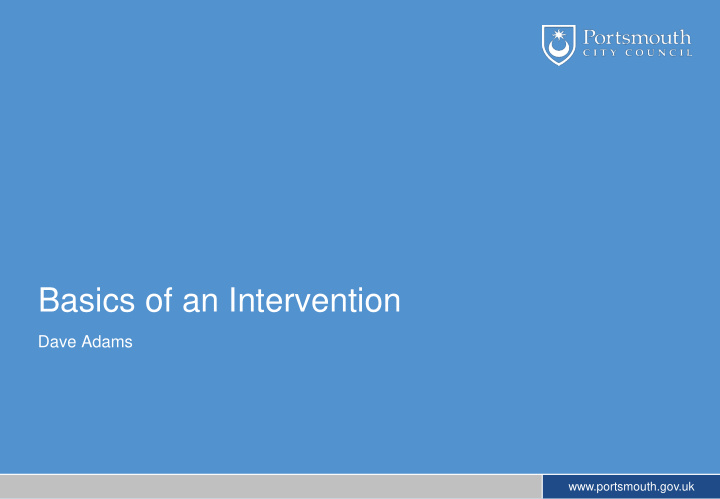



Basics of an Intervention Dave Adams www.portsmouth.gov.uk
Basics of an Intervention An ‘intervention’ is a three -stage process to adopt a fundamentally different perspective on the design and management of work. It can be done at various scales, but at service level would be a full time piece of work over several months, involving a team of staff and an interventionist (someone who can teach the team the systems thinking method). If performed effectively, with the required level of commitment, the results can be profound. www.portsmouth.gov.uk 2
A different approach to the design and management of work Traditional Thinking Vanguard Method Top-down Perspective Outside-in Functional specialisation Demand, Value and Flow Design Separated from work Decision-Making Integrated with work Budget, output, activity targets, Related to purpose, Measures standards etc capability, variation Extrinsic (carrot & stick) Motivation Intrinsic Manage budgets and people Ethic Act on system What matters…..? Contractual Attitude to customers Contractual Attitude to suppliers Partnering and co-operation www.portsmouth.gov.uk 3
Vanguard model for interventions www.portsmouth.gov.uk 4
Three stage process The intervention approach has three distinct phases, as follows: • Check – A study of the existing system • Redesign – Experimentation with new approaches • Roll-in – Scaling up and making the change sustainable There are decision points for leaders between each phase. www.portsmouth.gov.uk 5
Requirements for an intervention In order to perform ‘check’ on a whole service area/team, you would need: • 4-6 staff, ideally full- time, drawn on a ‘diagonal slice’ of the service structure (covering all core roles, if practical). • An interventionist to teach the method to the team. • A base room for the team to occupy throughout the work. • Access to staff and records, throughout the work. The ‘Check’ process typically takes 4 -6 weeks, depending on scale, at which point leaders decide whether to more to redesign or not. www.portsmouth.gov.uk 6
The Vanguard Model for ‘Check’ 6 Thinking 1 What is the purpose (in customer terms)? C U 5 System Conditions S T 4 Flow : Value work + Waste O M E R Capability of response 3 S Demand : V + F; T + F 2 What matters? www.portsmouth.gov.uk 7
Performing ‘Check’ The model for ‘Check’ is a forensic study of the system, largely from the perspective of the customer, aimed at understanding: • How much demand is there? What type(s)? Is there a high level of ‘failure demand’? • How capable are we of responding to that demand? Do we have measures that can tell us? • Is there waste in the core process flow? Why is that? What is the management thinking that created it? www.portsmouth.gov.uk 8
At the end of check… • Understanding the ‘what’ and ‘why’ of current performance; • Understanding the link between the thinking behind service design, the current system, and the ‘performance’ experienced by the customer; • Identified potential points of leverage for change and improvement In most cases the findings from Check would inform whether leaders want to move to redesign www.portsmouth.gov.uk 9
Vanguard Model for Redesign Act on System 1 What is the purpose? 6 Conditions What are the value steps? 2 C U 5 What are the S management roles? T Add value O M E What are the ‘core’ roles? 4 R Design against demand S 3 What are the measures? www.portsmouth.gov.uk 10 10
Redesign Redesign is primarily concerned with learning, by live experimentation, what it is possible to achieve – what ‘perfect’ would look like in the context of each service. In order to do this, the team establish the ‘value steps’ required to complete the core process flow, and create the necessary conditions to do only that work – this necessitates suspending existing processes, policies, and procedures (though the law obviously still stands!) www.portsmouth.gov.uk 11
Performing ‘Redesign’ Having established the work to be done, the team will take a series of real/live demands, and do the work required in a new way, with most/all of the existing system constraints ‘switched off’. They will measure the effectiveness of each attempt and learn what is possible and what barriers remain. They carry on taking demands and working them until they have established what the optimum process would look like. In most services, this will take about six weeks. www.portsmouth.gov.uk 12
At the end of Redesign… • You will have a prototype for a completely new core process • You will understand what core and management roles are required • You will understand the obstacles that need to be removed (eg policies, IT, authority levels) in order to have a clean process. Again, typically the findings are presented to leaders, with a decision to be made on whether to implement. www.portsmouth.gov.uk 13
Implementation If leaders decide to implement the redesigned model, the team develop a plan to do so. This will involve: • Building capacity by inducting all staff, individually, in the new ways of working. • Working with managers to ensure they understand their role in the change. • Continuing to remove and challenge systemic obstacles. • Aligning support flows to the new process (particularly IT) The duration of the implementation period depends on the scale and complexity of the service, and the receptiveness of leadership. www.portsmouth.gov.uk 14
Recommend
More recommend